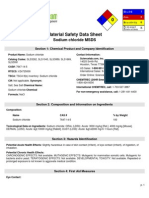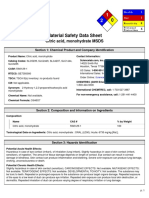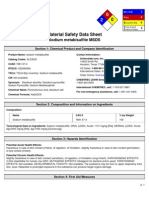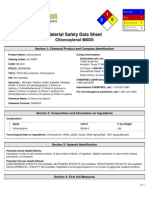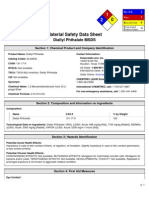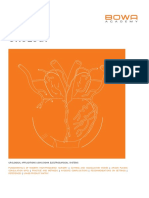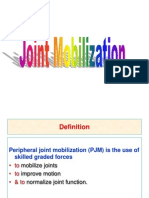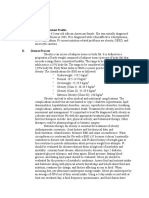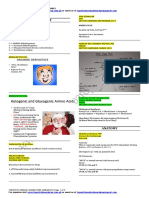Msds Thioacetamide
Msds Thioacetamide
Uploaded by
Oscar AvilesCopyright:
Available Formats
Msds Thioacetamide
Msds Thioacetamide
Uploaded by
Oscar AvilesOriginal Title
Copyright
Available Formats
Share this document
Did you find this document useful?
Is this content inappropriate?
Copyright:
Available Formats
Msds Thioacetamide
Msds Thioacetamide
Uploaded by
Oscar AvilesCopyright:
Available Formats
1 2
Material Safety Data Sheet
Thioacetamide MSDS
Section 1: Chemical Product and Company Identification
Product Name: Thioacetamide Catalog Codes: SLT1831, SLT3124 CAS#: 62-55-5 RTECS: AC8925000 TSCA: TSCA 8(b) inventory: Thioacetamide CI#: Not available. Synonym: Ethanethioamide; Acetothioamide; Thiacetamide; Thioacetimidic acid Chemical Name: Acetamide, thioChemical Formula: C2-H5-N-S Contact Information: Sciencelab.com, Inc. 14025 Smith Rd. Houston, Texas 77396 US Sales: 1-800-901-7247 International Sales: 1-281-441-4400 Order Online: ScienceLab.com
He a lt h
2 1 0 E
Fire Re a c t iv it y P e rs o n a l P ro t e c t io n
CHEMTREC (24HR Emergency Telephone), call: 1-800-424-9300 International CHEMTREC, call: 1-703-527-3887 For non-emergency assistance, call: 1-281-441-4400
Section 2: Composition and Information on Ingredients
Composition: Name Thioacetamide CAS # 62-55-5 % by Weight 100
Toxicological Data on Ingredients: Thioacetamide: ORAL (LD50): Acute: 301 mg/kg [Rat].
Section 3: Hazards Identification
Potential Acute Health Effects: Hazardous in case of skin contact (irritant), of eye contact (irritant), of ingestion, of inhalation. Slightly hazardous in case of skin contact (permeator). Potential Chronic Health Effects: CARCINOGENIC EFFECTS: Classified 2B (Possible for human.) by IARC. Classified 2 (Some evidence.) by NTP. MUTAGENIC EFFECTS: Mutagenic for mammalian somatic cells. Mutagenic for bacteria and/or yeast. TERATOGENIC EFFECTS: Not available. DEVELOPMENTAL TOXICITY: Not available. The substance may be toxic to liver. Repeated or prolonged exposure to the substance can produce target organs damage.
Section 4: First Aid Measures
Eye Contact: p. 1
Check for and remove any contact lenses. In case of contact, immediately flush eyes with plenty of water for at least 15 minutes. Cold water may be used. Get medical attention. Skin Contact: In case of contact, immediately flush skin with plenty of water. Cover the irritated skin with an emollient. Remove contaminated clothing and shoes. Cold water may be used.Wash clothing before reuse. Thoroughly clean shoes before reuse. Get medical attention. Serious Skin Contact: Wash with a disinfectant soap and cover the contaminated skin with an anti-bacterial cream. Seek immediate medical attention. Inhalation: If inhaled, remove to fresh air. If not breathing, give artificial respiration. If breathing is difficult, give oxygen. Get medical attention. Serious Inhalation: Not available. Ingestion: Do NOT induce vomiting unless directed to do so by medical personnel. Never give anything by mouth to an unconscious person. If large quantities of this material are swallowed, call a physician immediately. Loosen tight clothing such as a collar, tie, belt or waistband. Serious Ingestion: Not available.
Section 5: Fire and Explosion Data
Flammability of the Product: May be combustible at high temperature. Auto-Ignition Temperature: Not available. Flash Points: Not available. Flammable Limits: Not available. Products of Combustion: These products are carbon oxides (CO, CO2), nitrogen oxides (NO, NO2...). Fire Hazards in Presence of Various Substances: Slightly flammable to flammable in presence of heat. Explosion Hazards in Presence of Various Substances: Risks of explosion of the product in presence of mechanical impact: Not available. Risks of explosion of the product in presence of static discharge: Not available. Fire Fighting Media and Instructions: SMALL FIRE: Use DRY chemical powder. LARGE FIRE: Use water spray, fog or foam. Do not use water jet. Special Remarks on Fire Hazards: As with most organic solids, fire is possible at elevated temperatures Special Remarks on Explosion Hazards: Not available.
Section 6: Accidental Release Measures
Small Spill: Use appropriate tools to put the spilled solid in a convenient waste disposal container. Finish cleaning by spreading water on the contaminated surface and dispose of according to local and regional authority requirements. Large Spill: Use a shovel to put the material into a convenient waste disposal container. Finish cleaning by spreading water on the contaminated surface and allow to evacuate through the sanitary system.
Section 7: Handling and Storage
p. 2
Precautions: Keep away from heat. Keep away from sources of ignition. Ground all equipment containing material. Do not ingest. Do not breathe dust. Wear suitable protective clothing. In case of insufficient ventilation, wear suitable respiratory equipment. If ingested, seek medical advice immediately and show the container or the label. Avoid contact with skin and eyes. Keep away from incompatibles such as oxidizing agents, acids, alkalis. Storage: Keep container tightly closed. Keep container in a cool, well-ventilated area. Do not store above 8C (46.4F). Refrigerate.
Section 8: Exposure Controls/Personal Protection
Engineering Controls: Use process enclosures, local exhaust ventilation, or other engineering controls to keep airborne levels below recommended exposure limits. If user operations generate dust, fume or mist, use ventilation to keep exposure to airborne contaminants below the exposure limit. Personal Protection: Splash goggles. Lab coat. Dust respirator. Be sure to use an approved/certified respirator or equivalent. Gloves. Personal Protection in Case of a Large Spill: Splash goggles. Full suit. Dust respirator. Boots. Gloves. A self contained breathing apparatus should be used to avoid inhalation of the product. Suggested protective clothing might not be sufficient; consult a specialist BEFORE handling this product. Exposure Limits: Not available.
Section 9: Physical and Chemical Properties
Physical state and appearance: Solid. (Crystals solid.) Odor: Slight odor of mercaptans. Sulfurous. Taste: Not available. Molecular Weight: 75.13 g/mole Color: White to yellowish. pH (1% soln/water): Not available. Boiling Point: Not available. Melting Point: 113C (235.4F) - 114 C. Critical Temperature: Not available. Specific Gravity: Not available. Vapor Pressure: Not applicable. Vapor Density: Not available. Volatility: Not available. Odor Threshold: Not available. Water/Oil Dist. Coeff.: The product is more soluble in water; log(oil/water) = -0.3 Ionicity (in Water): Not available. Dispersion Properties: See solubility in water. Solubility: Soluble in cold water. Miscible in petroleum ether. Sparingly soluble in ether. Solubility in ethanol: 26.4 g/100 g. Solubility in water: 16300 mg/l @ 25 deg. C.
p. 3
Section 10: Stability and Reactivity Data
Stability: The product is stable. Instability Temperature: Not available. Conditions of Instability: Excess heat, incompatible materials Incompatibility with various substances: Reactive with oxidizing agents, acids, alkalis. Corrosivity: Non-corrosive in presence of glass. Special Remarks on Reactivity: Not available. Special Remarks on Corrosivity: Not available. Polymerization: Will not occur.
Section 11: Toxicological Information
Routes of Entry: Absorbed through skin. Inhalation. Ingestion. Toxicity to Animals: Acute oral toxicity (LD50): 301 mg/kg [Rat]. Chronic Effects on Humans: CARCINOGENIC EFFECTS: Classified 2B (Possible for human.) by IARC. Classified as anticipated carcinogen by NTP. MUTAGENIC EFFECTS: Mutagenic for mammalian somatic cells. Mutagenic for bacteria and/or yeast. May cause damage to the following organs: liver. Other Toxic Effects on Humans: Hazardous in case of skin contact (irritant), of ingestion, of inhalation. Slightly hazardous in case of skin contact (permeator). Special Remarks on Toxicity to Animals: Not available. Special Remarks on Chronic Effects on Humans: May affect genetic material (mutagenic). May cause cancer. May cause adverse reproductive effects and birth defects (teratogenic). Special Remarks on other Toxic Effects on Humans: Acute Potential Health Effects: Skin: Causes skin irritation. It may be absorbed through the skin and cause symtoms similar to that of ingestion Eyes: Causes eye irritation. Inhalation: May cause respiratory tract nose, throat, lungs) irritation causing coughing. Ingestion: Harmful if swallowed. It may cause diarrhea and painful or difficult urination. It may affect the liver and cause liver damage. Contact with stomach acids can liberate toxic hydrogen sulfide gas. Hydrogen Sulfide can cause diarrhea, nausea, excessive salivation, and can affect the central nervous system producing headache, weaknkess dizziness, excitement, staggering gait. Chronic Potential Health Effects: Ingestion: Prolonged or repeated ingestion may affect the liver (hepatitis, cirrhosis, hepatocellular necrosis), urinary system, blood (changes in serum composition), metabolism (loss appetite, weight loss), endocrine system (thymus, spleen). Skin: Prolonged or repeated skin contact can result in moderate to heavy skin irritation.
Section 12: Ecological Information
Ecotoxicity: Not available. BOD5 and COD: Not available. Products of Biodegradation: Possibly hazardous short term degradation products are not likely. However, long term degradation products may arise. Toxicity of the Products of Biodegradation: The products of degradation are less toxic than the product itself. Special Remarks on the Products of Biodegradation: Not available.
Section 13: Disposal Considerations
p. 4
Waste Disposal: Waste must be disposed of in accordance with federal, state and local environmental control regulations.
Section 14: Transport Information
DOT Classification: Not a DOT controlled material (United States). Identification: Not applicable. Special Provisions for Transport: Not applicable.
Section 15: Other Regulatory Information
Federal and State Regulations: California prop. 65: This product contains the following ingredients for which the State of California has found to cause cancer, birth defects or other reproductive harm, which would require a warning under the statute: Thioacetamide California prop. 65 (no significant risk level): Thioacetamide: 0.0001 mg/day (value) California prop. 65: This product contains the following ingredients for which the State of California has found to cause cancer which would require a warning under the statute: Thioacetamide Connecticut hazardous material survey.: Thioacetamide Illinois toxic substances disclosure to employee act: Thioacetamide Illinois chemical safety act: Thioacetamide New York release reporting list: Thioacetamide Pennsylvania RTK: Thioacetamide Minnesota: Thioacetamide Massachusetts RTK: Thioacetamide Massachusetts spill list: Thioacetamide New Jersey: Thioacetamide New Jersey spill list: Thioacetamide Louisiana spill reporting: Thioacetamide TSCA 8(b) inventory: Thioacetamide SARA 313 toxic chemical notification and release reporting: Thioacetamide CERCLA: Hazardous substances.: Thioacetamide: 10 lbs. (4.536 kg) Other Regulations: OSHA: Hazardous by definition of Hazard Communication Standard (29 CFR 1910.1200). EINECS: This product is on the European Inventory of Existing Commercial Chemical Substances. Other Classifications: WHMIS (Canada): The classification of this product has not been validated yet by the Service du repertoire toxicologique. However, the WHMIS can be expected to be CLASS D-1B: Material causing immediate and serious toxic effects (TOXIC). CLASS D-2A: Material causing other toxic effects (VERY TOXIC). DSCL (EEC): R22- Harmful if swallowed. R36/38- Irritating to eyes and skin. R45- May cause cancer. R52/53- Harmful to aquatic organisms, may cause long-term adverse effects in the aquatic environment. S45- In case of accident or if you feel unwell, seek medical advice immediately (show the label where possible). S53- Avoid exposure - obtain special instructions before use. S61- Avoid release to the environment. Refer to special instructions/Safety data sheets. HMIS (U.S.A.): Health Hazard: 2 Fire Hazard: 1 Reactivity: 0 Personal Protection: E National Fire Protection Association (U.S.A.): Health: 2 Flammability: 1 Reactivity: 0 Specific hazard: Protective Equipment: p. 5
Gloves. Lab coat. Dust respirator. Be sure to use an approved/certified respirator or equivalent. Wear appropriate respirator when ventilation is inadequate. Splash goggles.
Section 16: Other Information
References: Not available. Other Special Considerations: Not available. Created: 10/10/2005 12:03 AM Last Updated: 05/21/2013 12:00 PM The information above is believed to be accurate and represents the best information currently available to us. However, we make no warranty of merchantability or any other warranty, express or implied, with respect to such information, and we assume no liability resulting from its use. Users should make their own investigations to determine the suitability of the information for their particular purposes. In no event shall ScienceLab.com be liable for any claims, losses, or damages of any third party or for lost profits or any special, indirect, incidental, consequential or exemplary damages, howsoever arising, even if ScienceLab.com has been advised of the possibility of such damages.
p. 6
You might also like
- The Health & Safety Guide for Film, TV & Theater, Second EditionFrom EverandThe Health & Safety Guide for Film, TV & Theater, Second EditionRating: 4 out of 5 stars4/5 (1)
- Potassium Dichromate MSDS: Section 1: Chemical Product and Company IdentificationDocument6 pagesPotassium Dichromate MSDS: Section 1: Chemical Product and Company IdentificationRicky SetiawanNo ratings yet
- Msds NaclDocument6 pagesMsds NaclNur Oktri Mulya DewiNo ratings yet
- Sodium Chromate Anhydrous PDFDocument6 pagesSodium Chromate Anhydrous PDFErika WidiariniNo ratings yet
- Msds Asam TaninDocument6 pagesMsds Asam TaninArfin FardiansyahNo ratings yet
- Material Safety Data SheetDocument6 pagesMaterial Safety Data Sheetonna25No ratings yet
- Material Safety Data Sheet: Sodium Fluoride MSDSDocument7 pagesMaterial Safety Data Sheet: Sodium Fluoride MSDSjols76No ratings yet
- Msds CitricDocument6 pagesMsds CitricRamani Elampooranan K ENo ratings yet
- Msds KafeinDocument6 pagesMsds KafeinNovia Arinda Pradisty100% (1)
- MSDSDocument6 pagesMSDSAra HilisNo ratings yet
- Msds SalisilatDocument6 pagesMsds SalisilatMartha GamalNo ratings yet
- Msds Boric AcidDocument6 pagesMsds Boric AcidmeitakurniatiNo ratings yet
- 14.kalium DikromatDocument6 pages14.kalium DikromatDarla PowersNo ratings yet
- MsdsDocument6 pagesMsdsWind AzCaNo ratings yet
- Anhidrida Asetat MsdsDocument6 pagesAnhidrida Asetat MsdsmentaridaNo ratings yet
- Msds Na2so3Document6 pagesMsds Na2so3huythai2011No ratings yet
- Fecl3 6h2oDocument6 pagesFecl3 6h2omariyana kusumawatiNo ratings yet
- NaF MsdsDocument6 pagesNaF MsdsEko16No ratings yet
- Cobalt Chloride Hexahydrate MSDS: Section 1: Chemical Product and Company IdentificationDocument6 pagesCobalt Chloride Hexahydrate MSDS: Section 1: Chemical Product and Company IdentificationMiskya KyaNo ratings yet
- Glutaraldehide Cidex PDFDocument6 pagesGlutaraldehide Cidex PDFMelly SawitriNo ratings yet
- Ferric Chloride HexahydrateDocument6 pagesFerric Chloride HexahydrateDust HooNo ratings yet
- Urea MsdsDocument5 pagesUrea MsdsRea Candra OktaviaraNo ratings yet
- Acetophenone PDFDocument6 pagesAcetophenone PDFYuliana Ja'farNo ratings yet
- Acetophenon PDFDocument6 pagesAcetophenon PDFYuris Yurdiansah Munandar0% (1)
- Cacl 2Document5 pagesCacl 2Ahmed Qomaruddin100% (1)
- Sodium Metabisulfite MSDS: Section 1: Chemical Product and Company IdentificationDocument6 pagesSodium Metabisulfite MSDS: Section 1: Chemical Product and Company IdentificationfiifiabakNo ratings yet
- Atropine Ld50Document5 pagesAtropine Ld50valertronNo ratings yet
- Ferrous Sulfate MSDSDocument5 pagesFerrous Sulfate MSDSJonathan GonzalesNo ratings yet
- Citric Acid, Monohydrate MSDS: Section 1: Chemical Product and Company IdentificationDocument6 pagesCitric Acid, Monohydrate MSDS: Section 1: Chemical Product and Company Identificationgi3'No ratings yet
- 3-Aminobenzonitrile MSDS: Section 1: Chemical Product and Company IdentificationDocument5 pages3-Aminobenzonitrile MSDS: Section 1: Chemical Product and Company IdentificationAdi WibowoNo ratings yet
- Boric Acid MSDS: Section 1: Chemical Product and Company IdentificationDocument6 pagesBoric Acid MSDS: Section 1: Chemical Product and Company IdentificationRamanamurthy PalliNo ratings yet
- KSCNDocument6 pagesKSCNRiza GhulamNo ratings yet
- MsdsDocument5 pagesMsdsbindas4uNo ratings yet
- Msds BUTIRALDocument6 pagesMsds BUTIRALSatrio Rekso Hadi PNo ratings yet
- Phenolphthalein, Powder MSDS: Section 1: Chemical Product and Company IdentificationDocument6 pagesPhenolphthalein, Powder MSDS: Section 1: Chemical Product and Company IdentificationRika AriskaNo ratings yet
- Msds Kalium DikromatDocument6 pagesMsds Kalium DikromatKeynan HaqieNo ratings yet
- Na C2 O4Document5 pagesNa C2 O4Fernando AriantoNo ratings yet
- KCLO3Document6 pagesKCLO3Raditya Rizki AmaliaNo ratings yet
- MSDS Comassie BlueDocument5 pagesMSDS Comassie BlueExma Mu'tatal HikmahNo ratings yet
- Msds Asam BenzoatDocument5 pagesMsds Asam BenzoatveraniqueenNo ratings yet
- IodoformDocument6 pagesIodoformIchwan Gates SevenfoldismNo ratings yet
- Sodium Benzoate Desciption MsdsDocument5 pagesSodium Benzoate Desciption MsdsmeccalamataNo ratings yet
- Msds NH4ClDocument6 pagesMsds NH4Cl2imaNo ratings yet
- Protease 300 MCU MSDS: Section 1: Chemical Product and Company IdentificationDocument5 pagesProtease 300 MCU MSDS: Section 1: Chemical Product and Company IdentificationTaniadssNo ratings yet
- Msds BETAINEDocument5 pagesMsds BETAINEamiller1987No ratings yet
- MsdsDocument6 pagesMsdsscribdkthNo ratings yet
- Msdssodium Bisulfite MsdsDocument6 pagesMsdssodium Bisulfite MsdsSuth SeNo ratings yet
- Car Boxy Benz Alde HideDocument5 pagesCar Boxy Benz Alde HideReksy WibowoNo ratings yet
- A Consumerýs Dictionary of Household, Yard and Office Chemicals: Complete Information About Harmful and Desirable Chemicals Found in Everyday Home Products, Yard Poisons, and Office PollutersFrom EverandA Consumerýs Dictionary of Household, Yard and Office Chemicals: Complete Information About Harmful and Desirable Chemicals Found in Everyday Home Products, Yard Poisons, and Office PollutersNo ratings yet
- Skin Deep: The essential guide to what's in the toiletries and cosmetics you useFrom EverandSkin Deep: The essential guide to what's in the toiletries and cosmetics you useRating: 4 out of 5 stars4/5 (3)
- Georgia Pest Management Handbook: 2021 Home and Garden EditionFrom EverandGeorgia Pest Management Handbook: 2021 Home and Garden EditionEmily CabreraNo ratings yet
- Survival Skills: How to Survive Anything and Anywhere in the World (A Comprehensive Guide to Preparing for and Overcoming Challenges of Earthquakes)From EverandSurvival Skills: How to Survive Anything and Anywhere in the World (A Comprehensive Guide to Preparing for and Overcoming Challenges of Earthquakes)No ratings yet
- Go Toxic Free: Easy and Sustainable Ways to Reduce Chemical PollutionFrom EverandGo Toxic Free: Easy and Sustainable Ways to Reduce Chemical PollutionNo ratings yet
- Healthy, Happy Baby: The essential guide to raising a toxin-free babyFrom EverandHealthy, Happy Baby: The essential guide to raising a toxin-free babyNo ratings yet
- After a Disaster - Information to Help You and Your Family RecoverFrom EverandAfter a Disaster - Information to Help You and Your Family RecoverNo ratings yet
- Survival First Aid: How to treat injuries and save livesFrom EverandSurvival First Aid: How to treat injuries and save livesRating: 5 out of 5 stars5/5 (1)
- Side Effects of Systemic Corticosteroids in ChildrenDocument6 pagesSide Effects of Systemic Corticosteroids in ChildrenChamara AtukoralaNo ratings yet
- Not, Without: Root Word orDocument20 pagesNot, Without: Root Word orSakhawat AliNo ratings yet
- AscitesDocument4 pagesAscitesmohannadNo ratings yet
- Health InsuranceDocument5 pagesHealth Insurancesoumya.shrivastava20No ratings yet
- Anesthesiology SamplexDocument17 pagesAnesthesiology SamplexAudrey CobankiatNo ratings yet
- Urology: Urological Applications Using Bowa Electrosurgical SystemsDocument24 pagesUrology: Urological Applications Using Bowa Electrosurgical SystemsMohamedNo ratings yet
- OncoDocument3 pagesOncoTni JolieNo ratings yet
- Mechanisms of Autoimmunity: - Recent ConceptDocument4 pagesMechanisms of Autoimmunity: - Recent ConceptAdhimas Rilo PambudiNo ratings yet
- Nutritive ValueDocument25 pagesNutritive Valuedhruvamishra100% (4)
- Form300Document6 pagesForm300Harish ChandNo ratings yet
- MCQs 2008 1 With Key AnswersDocument62 pagesMCQs 2008 1 With Key AnswersAsma SukarNo ratings yet
- Peripheral Joint MobilizationDocument20 pagesPeripheral Joint MobilizationLove_dove612100% (1)
- Okabayashi LaskoDocument1 pageOkabayashi LaskoMarta Betti100% (1)
- Clin Management Sepsis Management Adult Web AlgorithmDocument4 pagesClin Management Sepsis Management Adult Web AlgorithmfaisalbasraNo ratings yet
- Introduction To CT ScanDocument17 pagesIntroduction To CT ScansanyengereNo ratings yet
- The World Healthiest Foods Part III - FruitsDocument39 pagesThe World Healthiest Foods Part III - FruitsKyle J. NortonNo ratings yet
- Multiple Myeloma Case Studies (Tandem 2017) (Final)Document52 pagesMultiple Myeloma Case Studies (Tandem 2017) (Final)Syed Ali Akbar100% (2)
- Secondhand SmokeDocument3 pagesSecondhand SmokeAnas AnsariNo ratings yet
- Musculoskeletal RadiologyDocument103 pagesMusculoskeletal RadiologyPatresya LantanNo ratings yet
- ORN of Jaw Feb22Document4 pagesORN of Jaw Feb22naveedtariqsyedNo ratings yet
- Clinical Practice Guidelines - 2017 PDFDocument820 pagesClinical Practice Guidelines - 2017 PDFvijay kumarNo ratings yet
- Efectos de La Terapia en Disfonia Musculotensional.2017Document7 pagesEfectos de La Terapia en Disfonia Musculotensional.2017Jenith Karem Paredes GonzalezNo ratings yet
- Obesity Case StudyDocument4 pagesObesity Case Studydsaitta108No ratings yet
- Specialist Infant MilkDocument166 pagesSpecialist Infant MilkannisanangNo ratings yet
- Peadiatric Brain Tumour: Wong Ann Cheng MD (Ukm) MRCPCH (Uk)Document48 pagesPeadiatric Brain Tumour: Wong Ann Cheng MD (Ukm) MRCPCH (Uk)An Zheng100% (4)
- 65 2 37 395 PDFDocument6 pages65 2 37 395 PDFletter2lalNo ratings yet
- ArpitDocument73 pagesArpitDurgesh PushkarNo ratings yet
- Sun 2016Document6 pagesSun 2016Dandara AraujoNo ratings yet
- Topnotch Mnemonics - March 2019Document9 pagesTopnotch Mnemonics - March 2019euphrosyne92100% (1)
- Kounis Syndrome Poster - MadgulaDocument1 pageKounis Syndrome Poster - MadgulaAnantha MadgulaNo ratings yet


